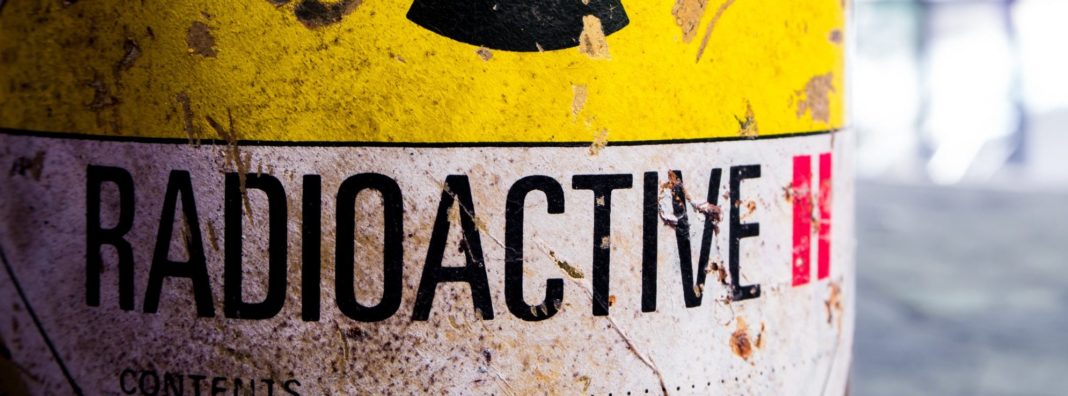
Last month, I wrote a post about how misperceptions and misinformation surrounding nuclear energy has proven to be more dangerous than the technology itself. And, as luck would have it, just a week later, I got to witness an incident involving potentially radioactive material, public exposure, and misinformation play out right here in my hometown.
The lid that caused all the fuss.
On November 18th, a student at Utah State University found an old metal lid in the crawlspace of his friend’s home. What was interesting about that lid was that on top of it was a sticker with the words “RADIOACTIVE MATERIAL” written across it in bright red. The student uploaded an image of the lid to Reddit, an online web forum, hoping to get some clarity on what he had discovered. Within a matter of hours, the post had gone viral, moving to the front page of the internet’s most popular forum and receiving over 4,000 comments from interested and concerned users.
The majority of the comments were focused on the possible dangers of the lid and the need to contact the police or a government bureau immediately (numerous people mentioned contacting the Nuclear Regulatory Commission themselves, reaching out to Idaho National Labs, Hill Air Force Base, the Department of Defense, etc.). There were calls for the student to see a doctor immediately. Warnings that the house needed to be evacuated. The post created quite a stir.
Eventually, the Utah Division of Waste Management and Radiation Control showed up to inspect the house and found no abnormal levels of radiation. Ty Howard, Director of the Division, commented that the post “probably generated a lot of hysteria for nothing.”
As a follow-up to last month’s post, today I’m sharing a little bit more about what exactly radiation is, why it isn’t as dangerous as many people think it is, and why it is essential to understand the real risks of nuclear, so we don’t lose out on a valuable source of clean energy due to public misperceptions.
What does all of this have to do with Thanksgiving?
Think back to your Thanksgiving. Did you hop on a plane to head somewhere for Thanksgiving? Did your Thanksgiving feast include banana cream pie? Was it prepared in a kitchen with granite countertops? Did you, perhaps, venture outside to take a walk afterward? If you did any of these things, you exposed yourself to radiation. Figure 1 breaks down the percentages of sources for background radiation. That is, ionizing radiation that we are exposed to daily.
Radiation is all around us. It is, quite literally, unavoidable. It is the byproduct of unstable elements, which occur naturally, shedding subatomic particles until they reach a stable state. That doesn’t mean it isn’t dangerous. Still, in the same way, that jumping over a candle is much less dangerous than jumping over a campfire or even a bonfire, exposure to radiation is only dangerous if it occurs in vast amounts. Fortunately for us, our bodies can tolerate a fair amount of radiation.
In the case of nuclear power, nuclear fuel is that bonfire…if it were a really, really, REALLY large bonfire. That’s because ionizing radiation is what creates nuclear energy. Uranium is one of those naturally occurring unstable elements I mentioned before. To make it useful as nuclear fuel, we enrich it, which is another way of saying we turn it from an unstable element to a highly unstable element. That high instability is also what makes it highly radioactive. Remember, radiation is energy. When you pack all that unstable uranium together into fuel rods, it creates a chain reaction, splitting the uranium atoms and releasing massive amounts of heat.
Granted, if this process is not controlled, it can be perilous. But every power plant in the US comes with several built-in safety features meant to prevent this “bonfire” from getting out of control and resulting in a meltdown. Newer reactors are being designed in such a way that it is physically impossible for a meltdown to occur.
The radioactive leftovers
Recent anti-nuclear arguments surrounding nuclear energy, however, often relate to the difficulty of handling nuclear waste, which is the radioactive material left over after the fuel rods have been used up. Again, these are highly radioactive materials that can be lethal if you are directly exposed to them. Still, you may be surprised at how easy it is to prevent radiation from escaping into the environment. Materials used to prevent the movement of radiation are often referred to as shields. You likely wore one last time you got an x-ray.
Once a fuel rod is removed from a reactor, it is typically placed into a pool of water to cool for anywhere from 3 years to a decade. That’s because water is an incredibly useful radiation shield. If you’ve ever seen a video of someone firing a bullet into a pool of water, the effect on radiation behaves similarly. If you haven’t, well, a bullet moving at supersonic speeds fired into a pool of water will only travel about three feet before disintegrating. Radioactive particles are like tiny bullets and struggle to go through water.
An excellent illustration of the effectiveness and relative safety of storing control rods in cooling pools comes from the webcomic XKCD (Fig2.). In What If, by the webcomic’s author Randall Munroe, he depicts how sufficient water is at stopping radiation from harming people. Water is so effective that it cuts radiation levels from nuclear fuel in half every 3 inches. That means that with just 6 feet of water between you and a highly radioactive fuel rod, you are receiving less radiation from the fuel rods than you are from natural background sources outside of the pool.
Figure 2: What Lies Beneath
Source: XKCD
Once those rods have cooled sufficiently, they are moved to dry cask storage, which are large steel cylinders that act as another radiation shield. According to the Nuclear Regulatory Commission (NRC):
“Since the first casks were loaded in 1986, dry storage has released no radiation that affected the public or contaminated the environment.”
Multiple studies by the NRC have shown that not only do dry cask storage containers pose very little health threat, but the process of loading and storing the containers also poses little to no health threats.
These casks are only meant to serve as temporary storage for nuclear fuel until it can be moved to a more permanent, long-term storage facility, but currently, a facility like that doesn’t exist in the US. Yucca Mountain, a storage facility in the Nevada desert, was planned as a long-term storage solution. Still, public opposition from state leaders and residents have played a role in stalling that project. Similar efforts are playing out in states like New Mexico and Texas right now.
Unfortunately, stalling efforts to find a final resting place for the country’s spent nuclear fuel is driving up the cost of nuclear energy. So far, it has cost ratepayers around 40 billion dollars. It’s also preventing us from being able to take advantage of a safe and reliable form of energy that creates no greenhouse gas emissions.
Taking a zero-tolerance approach to radiation exposure is not only unnecessary, but it is also increasing the cost and opposition of one of our best options for clean, reliable energy. The discovery of a possible radioactive lid in an old crawl space should rightly be treated with caution, but it is hardly a public security threat. Hopefully, after reading this, you are more comfortable with the idea of radiation. I’m not advocating you offer up your backyard swimming pool as a storage site for spent nuclear fuel, but a better understanding of the issue could go a long way to improving the future of clean energy in this country.

